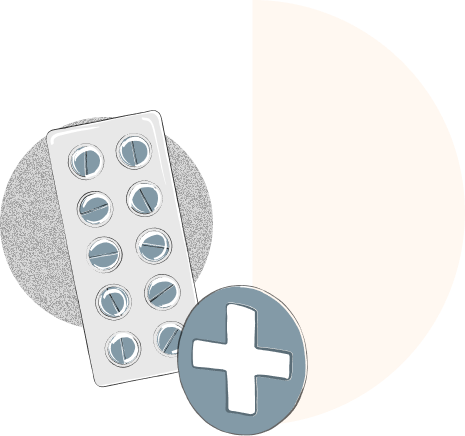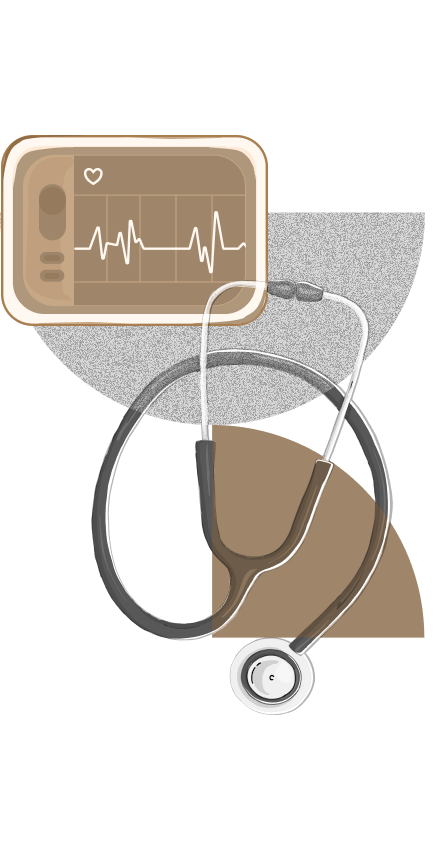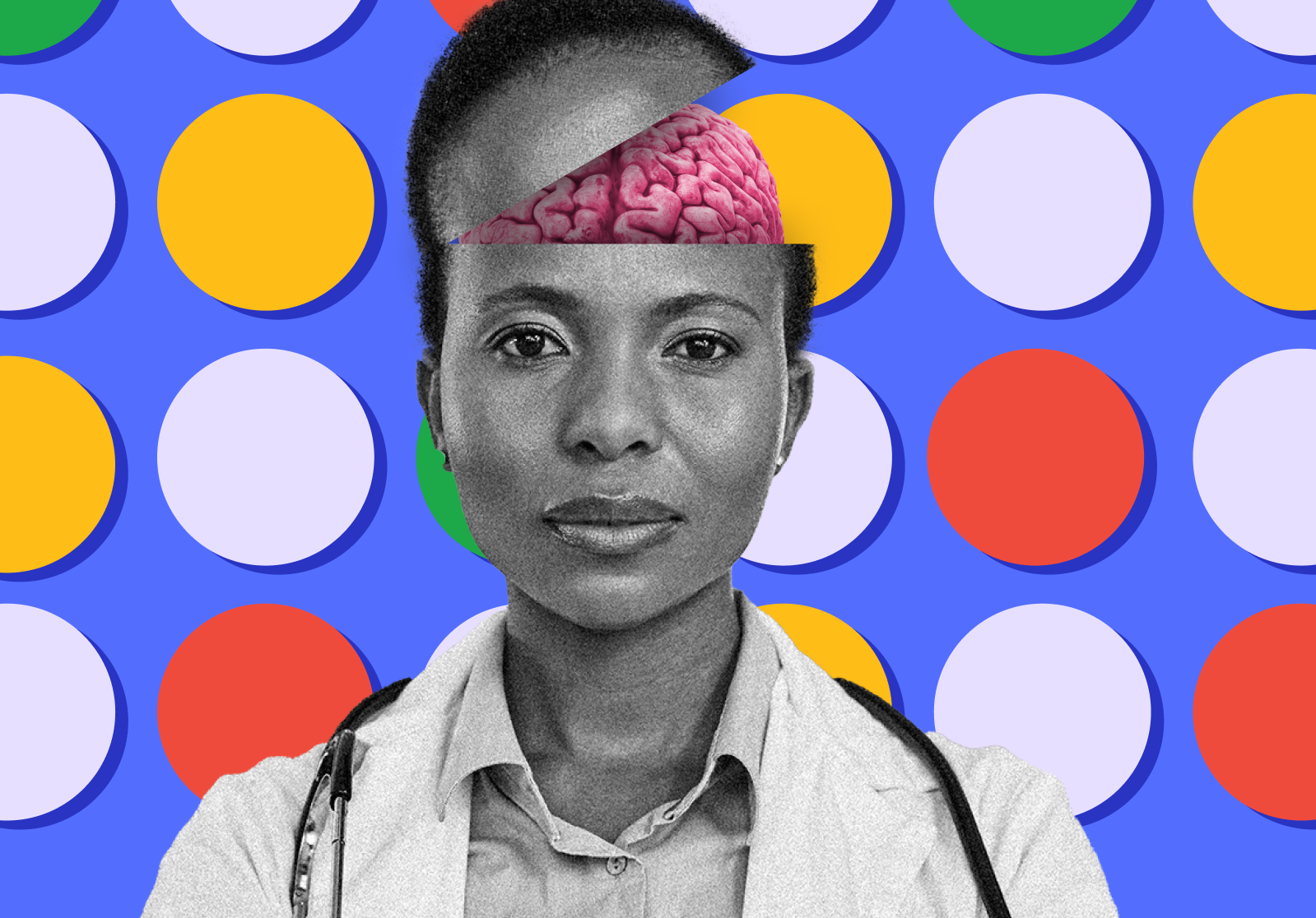
Emergent science and technologies alongside shifting norms and values in healthcare are calling for a change in the operational models of the life sciences industry. By keeping an eye on the potentially transformative changes ahead, the life sciences industry can better position themselves to support HumanCare as it relates to the overall experience of care Foresight as a systematic, future gathering and vision building process which aims at enabling present-day decisions and mobilizing actions.
In this mini study, we present four possible futures of healthcare toward 2030 using our unique blend of foresight research tools and techniques. It is designed to inform and inspire decision-makers in life sciences, facilitating their short-term and long-term strategic planning and innovation efforts.
The Critical Uncertainties
& Drivers of the Present
& Drivers of the Present

- The healthcare industry is undergoing a massive transformation at the nexus of technological disruption, social change, and economic shifts. The aftermath of a global pandemic, in particular, has raised new challenges, further compounded existing challenges, highlighted new opportunities, and accelerated advances in biomedical sciences as well as innovations in care delivery. But much uncertainty remains. Research suggests there are four primary factors or drivers of change poised to shape healthcare of the future, but how they will collide in order to change the status quo remains ambiguous.
- 01. Crises of Affordability
We are currently living with an affordability crisis in healthcare. Health expenditure is up, while economic growth is low, and health expenditure growth could exceed economic growth by up to 5.9% in 2023, creating enormous affordability pressure on healthcare users, particularly in uncertain economic scenarios.

Using Scenarios
to Explore Ambiguity
to Explore Ambiguity
There are no future facts—we cannot know the future in the same way that we know the present or past. It is less about estimating uncertainties, which is the goal of forecasting, and more about exploring them. Thus, scenarios do not predict, nor do they attempt to predict the future—they are devices to disturb the present. Scenarios illustrate how an organization might live within and succeed in both favourable and less-than-favorable future worlds, and they demonstrate what choice-actions and outcomes a decision-maker might encounter along the way. Scenarios act as a dynamic long-term planning tool, offering organizations a framework for resilience by enabling them to think critically about how a current strategy or vision will hold up against possible futures and the opportunities and threats those futures may yield.

Four Future
Healthcare Scenarios:
Future 01
Luxury Care Circles
Luxury Care Circles
A scenario about increasing healthcare costs and increasing levels of patient support
An oncologist for almost 20 years, Dr. Jennings walks into her office and follows her daily routine. She hangs up her coat, gets settled into her chair, and pulls open her laptop to check her emails. She hears a knock at the door, one of the nurses comes in to provide her with a run-down of the day and a list of patients with appointments. She looks to the column right of the patients’ names and observes the prescription level each patient is on. She makes a mental note of the patients without prescriptions, and to be mindful of the associated costs of treatments.
Dr. Jennings' first patient of the day is a newly diagnosed breast cancer patient who is feeling anxious about her visit. Reviewing the genomic sequencing data in her profile, Dr. Jennings reassures her of the many treatment options available to her. From immunotherapy, to targeting new mutant proteins and identifying their weaknesses, she begins by walking her through a personalized treatment based on her genetic information. Slowly, she notices her patient's demeanor begins to calm, as she focuses on asking questions about next steps. When Dr. Jennings mentions the costly impact of personalized therapies, the patient is reassured her insurance can cover it and agrees to further testing. After the patient leaves the clinic, Dr. Jennings feels slightly relieved – starting off the day optimistic.
The next few hours are filled back-to-back with appointments until Dr. Jennings switches over into telehealth mode. The patients she interacts with virtually on a regular basis are on higher tiered prescription levels, and as a result have positive check-ins with precise HCP monitoring. While she enjoys interacting with patients, these virtual visits are very detail oriented and are booked consecutively after one another, leaving Dr. Jennings feeling exhausted going from patient to patient. As she feels her energy slowing down, Dr. Jennings transfers her patients over to the nursing team whenever she encounters a challenge with insurance or access to a medication.
As she reviews the file for the last patient of the day, Dr. Jennings notices this patient is currently on chemotherapy and radiotherapy treatments. When the patient walks in, she can tell by their demeanor that the patient is not doing well. Remembering this patient is on the lowest prescription access tier, Dr. Jennings reminds herself to be mindful of financial barriers while also providing the best quality of care. After a discussion about symptoms and next steps, the patient becomes overwhelmed by the process, putting their hands onto their head trying to conceal tears. They are unable to afford the next level of care for physical and emotional support and are left feeling abandoned.
After the patient leaves, Dr. Jennings feels defeated. She's tried her best to connect the patient with different advocacy and patient support programs but is limited by the options of support that are within the patient’s range. Over the past couple of years, she notices the disparities between patients have become more apparent, with seamless care for those who can afford it, and fragmented care for those who can’t. As she wraps up the day sifting through emails from clinic staff, pharma reps, and journal studies, Dr. Jennings can’t shake the feeling in her gut – she wishes she could do more but feels she’s done all she can. She heads home feeling drained, thinking about all the patients who couldn’t afford more care.
Greater socio-economic inequalities in a world with more effective technology can lead to greater disparities impacting not only patients but HCPs as well, as a result Physicians will be impacted by burnout.
How might we ensure that cost doesn’t hinder the impact of new innovations on the quality of care patients receive?
How might we be mindful of how to distribute innovation to prevent further divides?
How might we ensure that cost doesn’t hinder the impact of new innovations on the quality of care patients receive?
How might we be mindful of how to distribute innovation to prevent further divides?

Future 02
Digital Health Ecosystems
Digital Health Ecosystems
A scenario about decreasing healthcare costs and increasing levels of patient support
Michelle wakes up to the smell of a summer’s day BBQ in her dark bedroom, except it is 6:00 am and this isn't a neighborhood BBQ. She immediately recognizes the smell as the roaring wildfire that has engulfed a forest area about 200 miles from her house. This has been the reality every summer in Washington for over a decade, contributing to high rates of respiratory illnesses and rare forms of cancer in the local population.
Michelle, herself, was recently diagnosed with triple-negative breast cancer. A diagnosis which came late because she had been neglecting her own health and avoiding the online reminders for checkups from the digital nurse coordinator at her clinic.
A few months ago, she experienced swelling in her breast on a family vacation which finally prompted her to make an appointment with her primary care provider (PCP). With appointments available through the clinic’s online conferencing system, Michelle was able to see her PCP while on vacation, who referred her for a breast cancer at-home screening kit that would be delivered straight to her house and an automatic transfer over to an oncology clinic to take over the subsequent testing. The at-home test, using her tears to look for protein biomarkers, and an efficient mammogram result accelerated by an algorithm, confirmed Michelle’s triple-negative breast cancer diagnosis.
What came as a shocking diagnosis, was immediately soothed by Michelle’s organized and proactive oncology care team. They set her up on their specialized platform CanCare, which served as a hub for all her cancer care needs. A fully virtual platform meant no added cost for Michelle in onboarding and accessing the different services. The platform took care of many aspects of the care – education on treatment options and living with cancer, discussion groups in which Michelle could ask any queries she had, quick access to test results for both her and her care team, and ongoing informal check ins between her and the oncologist’s assistant which saves her from visiting the clinic often and keeps her oncologist informed.
Back to the present day, Michelle gets out of bed and starts getting ready for her day. Her phone buzzes with a reminder from CanCare. Today she will be going into the clinic to talk with her oncologist about a newly approved treatment approach, personalized for her type of cancer, which targets a mutant protein that helps cancer cells in triple-negative breast cancer. Excited about the prospect of something other than her chemotherapy, Michelle pushes through her daily exercise plan adapted to her condition. Her clinic has their own in-house physical specialist who uses the virtual platform to send weekly aerobic and resistance exercise plans – a common set up in oncology care after years of studies supporting the benefit of exercise programs for breast cancer patients.

Michelle finds she has a greater sense of peace about her journey ahead as she heads out for a day of cancer care appointments. After her oncologist appointment, she has her visit to the counseling center where she meets with fellow patients and mental health therapists to support her through this arduous journey.
As she arrives home she is hit by the strong burning smell, she reflects on her journey so far, all the resources she has available at her fingertips and how seamlessly all aspects of her care are integrated together with no extra expense.
Digital acceleration has the potential to reduce healthcare costs and increase patient support. Progress in treatment strategies must go hand-in-hand with seamless connectivity to have a profound impact on overall care.
How might we optimize present-day digital innovation in oncology to provide more accessible care to cancer patients in the future?
How might we optimize present-day digital innovation in oncology to provide more accessible care to cancer patients in the future?
Future 03
Healthcare Anonymous
Healthcare Anonymous
A scenario about decreasing healthcare costs and decreasing levels of patient support
- Samir starts his day off by brewing some coffee, and making breakfast for himself and his mother, Salma. Living with rheumatoid arthritis for the past 5 years, Salma confidently gets around their home, but the tenderness she feels in her hands limits her from engaging in tactile activities. Although Samir loves to experiment with his cooking and trying new things, he sticks with a recipe that uses probiotics to decrease inflammation and increase immunity. Samir notices how tired his mother looks, as she struggles to fall asleep each night.
- Working a part time remote job, Samir takes turns with his siblings to look after Salma and help her to live a full life. Despite buying their mom all the latest gadgets to help her live day to day, Salma struggles to engage with technology and often requires the help of her children. During their last visit to the doctor’s office, Salma’s primary care physician recommends an AI monitoring device to provide real time tracking data back to an RA focused clinic. Although Salma initially feels hesitant about another new form of technology, Samir figures it wouldn’t hurt and could help track how the disease is progressing. Once Salma is on board, Samir encounters his next challenge – how to go about obtaining and setting the device up?
The next time they visit the clinic, Samir senses tensions with the healthcare team. In the past when he visited with his mother, he would have gone up to a member of the healthcare team to understand the results of Salma’s blood tests and how she is responding to biologic treatment. But over the past couple of years, he’s noticed their keenness to support has been diminishing. Taking his mother to the car, he wonders whether to go to a pharmacy to obtain the AI monitoring device or to purchase it online, he also wonders how the results will get back to him? He decides by the exhausted and frustrated looks of the healthcare team that he’ll just go home to figure it out. He doesn't want to make his mother endure another waiting process.
Back at home, Salma goes to her room to watch a television show. Clinic visits leave her feeling drained and anxious. In the meantime, Samir goes to his office to get some work done. Trying to focus on the task at hand, Samir can’t seem to concentrate. He understands the constant burnout and turnover of healthcare teams these days but feels frustrated that he can’t get the support he needs to help Salma. He turns to his computer and looks into an online RA focused forum that he’s familiar with. While searching for information on how to obtain and set up the monitoring device, Samir encounters a thread with significant traction on group therapy for RA patients suffering with insomnia.

He looks through the thread and notices it’s a 6-week, nurse-led cognitive behavioral therapy course with potential to induce meaningful effects on RA patient outcomes. Samir thinks of Salma, waking up every day – tired and lacking energy. He decides to order the monitoring device he’s been looking for, then downloads the CBT-I app. Time to try something new.
What if opportunities existed to support patients who feel disconnected from their healthcare teams?
Think about ways to utilize technology and support programs to provide patients with the information they need and seamless ways to obtain it.
Think about ways to utilize technology and support programs to provide patients with the information they need and seamless ways to obtain it.
Future 04
A Fragmented Health World
A Fragmented Health World
A scenario about increasing healthcare costs and decreasing levels of patient support
Since beginning her new nursing job at the hospital, Alisha spends her mornings grabbing coffee from the hospital cafe. With the limited time she has, waiting in line feels like a moment of self-care. Working in the Rheumatology clinic, she finds herself taking on several roles at once. Not only is she performing blood tests, infusion, and PET/CT scans, but she’s often learning new technologies on the job in order to try and keep up.
In nursing school, she was aware of the digital transformations in healthcare, but wasn’t fully prepared to experience the learning curve that came with it. Nowadays it seems like every device and process is tracked or has its data filtered by algorithms. In her current position, Alisha occasionally feels overwhelmed by all the new platforms. When she asks her higher ups for support, they are so busy taking care of their own patients that Alicia hesitates to ask more from them. The doctors who are unfamiliar with the technology have started to pass along their tasks to the nurses, who already have their plates full. As a result, Alisha retreats from asking the higher ups questions unless necessary, she tries her best to figure things out on her own.


With the availability of take-home monitoring devices, Alisha spends a great deal of her time guiding and talking patients through set up, connection and maintenance. Although this isn’t her primary area of expertise, she recognizes the importance of technologic interaction and patient adherence and wants to ensure that patients feel properly onboarded. While she spends time explaining to patients how devices sync up with their smartphones, Alicia finds that a lot of the information flies over patients’ heads, especially older patients. Although she tries her best, whenever the technology set up doesn’t go smoothly, Alisha can feel the frustration of her patients, which translates into her own frustration. Adding to that frustration are the difficult conversations she must have with her low-income patients, gently having to let them know that they can’t receive the same technological assistance due to the cost.
On top of everything, Alicia’s exasperation grows when she finds herself dealing with insurance and access challenges. In constant communication with insurance providers, Alisha becomes irritated when she can’t find a solution to help her patients' needs, especially with the increased cost over the last few years. She goes out of her way to talk to pharmacies ahead of time, and different healthcare providers to try and set her patients up for success. As a result of the difficulties they face on a regular basis, Alisha and a couple of other new nurses band together to communicate and support each other as they navigate the challenges they encounter. They’ve recently connected about immunological patient advocacy groups and have started to tell patients to go there to find additional support.
After a long day of calls, troubleshooting and regular patient duties, Alisha finally has a chance to go home. However, instead of spending her time away from work relaxing, she spends her evenings trying to read up on the latest devices in order to feel better prepared for work. Since access to these devices is extremely costly, patients are very careful to book their appointments or purchase devices. Any mistakes Alisha makes on the job can not only slow down processes but impact her patient’s financial situations as well. She eats a quick dinner and eventually falls asleep, ready to start this long process all over again tomorrow.

What if opportunities existed to support nurse education gaps as they become digital leaders in the healthcare space?
What if opportunities existed to create patient advocacy and support adherence in ways beyond the hospital setting, especially in accessing financial assistance?
Think about ways to streamline learning curves or provide support for patients despite rising costs.
What if opportunities existed to create patient advocacy and support adherence in ways beyond the hospital setting, especially in accessing financial assistance?
Think about ways to streamline learning curves or provide support for patients despite rising costs.
Imagining New Possibilities
with Change Scenarios
with Change Scenarios
- Scenarios represent charismatic design fictions that intend to communicate possible futures through compelling storytelling, engaging narratives, and a careful consideration of design and concept visualization. Truly rich and inspiring scenarios lead people to naturally consider the implications of future worlds in an intuitive way, much like a great science fiction story or film. In reflecting on these perspectives, imagine your organization in the context of these possible scenarios, and consider how you might leverage these insights to insulate business assets, fuel ideation and innovation, improve organizational learning, enhance strategic resilience, and better manage complexity.
- Insulating Assets
Scenarios are a proactive tool that helps businesses identify, analyze, plan, and innovate around potential disruptions and blindspots. The changing conditions and cross-impacts revealed through scenario planning allow businesses to insulate their assets and investments, such as their infrastructure and real estate, product and service pipelines, talent and human capital, raw materials and energy, and supporting logistics and supply chains. By exploring the movement of key mechanisms in the external environment and examining the recurring patterns that emerge, organizations can contextualize their current threats within a more robust framework and develop strategies that are immune to – or flexible enough to withstand – large-scale change.

Fuel Ideation
Scenarios are also regularly applied in the context of ideation and opportunity identification. They establish a platform for structured ideation and create the context that allows organizations to shift their thinking beyond the scope of their business and industry. The process of reimagining the future of a business and situating this image within a detailed narrative can unlock areas of thinking that had been previously overlooked or under-explored. Scenario planning allows businesses to challenge long-standing assumptions and overcome biases that have colored their depiction of the future, thereby opening them up to new opportunities on the horizon and to the innovation requirements needed to capitalize on those opportunities.
Scenarios are also regularly applied in the context of ideation and opportunity identification. They establish a platform for structured ideation and create the context that allows organizations to shift their thinking beyond the scope of their business and industry. The process of reimagining the future of a business and situating this image within a detailed narrative can unlock areas of thinking that had been previously overlooked or under-explored. Scenario planning allows businesses to challenge long-standing assumptions and overcome biases that have colored their depiction of the future, thereby opening them up to new opportunities on the horizon and to the innovation requirements needed to capitalize on those opportunities.
Organizational Learning
Scenario planning has been cited as a tool for constructing and improving mental models and organizational cultures. It helps business leaders and employees build consensus and align on internal objectives by creating a platform that allows them to make difficult strategic discussions together using a set of shared future outlooks. Scenarios represent a collaboration tool for bold, long-term thinking that supports the establishment of a common vision and strategic direction.
Scenario planning has been cited as a tool for constructing and improving mental models and organizational cultures. It helps business leaders and employees build consensus and align on internal objectives by creating a platform that allows them to make difficult strategic discussions together using a set of shared future outlooks. Scenarios represent a collaboration tool for bold, long-term thinking that supports the establishment of a common vision and strategic direction.
Future of HealthCare Contributors:
Editor: Karen McCauley
Strategic Foresight Practitioners: Ireena Haque,
Patricia Zawada & Kyle Brown
Project Manager: Khadijah Deshong
Design team: Gabriel Lopes & Utkarsh Subnis




